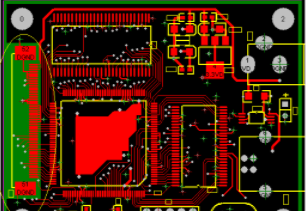The role of circuit board capacitors in PCB design
Filtering function: In the power circuit, the rectifier circuit turns AC into pulsating DC, and a larger capacity electrolytic capacitor is connected after the rectifier circuit, and its charge and discharge characteristics (energy storage function) are used to make the rectified The pulsating DC voltage becomes a relatively stable DC voltage. In practice, in order to prevent the power supply voltage of each part of the circuit from changing due to load changes, electrolytic capacitors of tens to hundreds of microfarads are generally connected to the output end of the power supply and the power input end of the load. Since large-capacity electrolytic capacitors generally have a certain inductance and cannot effectively filter out high-frequency and pulse interference signals, a capacitor with a capacity of 0.001--0.lpF is connected in parallel at both ends to filter out high-frequency And pulse interference.
Coupling: In the process of low-frequency signal transmission and amplification, in order to prevent the static operating points of the front and rear circuits from interacting with each other, capacitor coupling is often used. In order to prevent excessive loss of low-frequency components in the signal, a larger capacity is generally used. Large electrolytic capacitor.

Judgment methods for common faults of electrolytic capacitors
The common faults of electrolytic capacitors are: capacity reduction, capacity disappearance, breakdown short circuit and leakage. The capacity change is caused by the gradual drying of the electrolyte inside the electrolytic capacitor during use or placement, and breakdown and leakage are generally caused by excessively high applied voltage or poor quality. To determine the quality of the power supply capacitor, the resistance profile of a multimeter is generally used for measurement.
The specific method is: short-circuit the two pins of the capacitor to discharge, and connect the black pen of a multimeter to the positive electrode of the electrolytic capacitor. Connect the red test lead to the negative pole (for an analog multimeter, the test leads will be inter-adjusted when measuring with a digital multimeter), and a normal hour meter.
The needle should first swing in the direction of low resistance, and then gradually return to infinity. The greater the swing of the hands or the slower the return speed, the greater the capacity of the capacitor, and vice versa, the smaller the capacity of the capacitor. If the pointer of the meter no longer changes somewhere in the middle, it indicates that the capacitor is leaking. If the resistance value is very small or zero, it indicates that the capacitor has broken down and short-circuited. Because the voltage of the battery used by the multimeter is generally very low, it is more accurate when measuring low withstand voltage capacitors. When the withstand voltage of the capacitor is high, although the measurement is normal, when the high voltage is added, leakage or shock may occur. Wear phenomenon.
Precautions for using electrolytic capacitors in PCB circuit design
Since electrolytic capacitors have positive and negative polarity, they cannot be connected upside down when used in a circuit. In the power circuit, when outputting a positive voltage, the positive electrode of the electrolytic capacitor is connected to the output terminal of the power supply, and the negative electrode is grounded. When a negative voltage is output, the negative electrode is connected to the output terminal and the positive electrode is grounded. The filtering effect is greatly reduced. On the one hand, it causes the output voltage of the power supply to fluctuate, and on the other hand, the electrolytic capacitor, which is equivalent to a resistor, heats up due to the reverse energization. When the reverse voltage exceeds a certain value, the reverse leakage resistance of the capacitor will change It must be very small, so that the capacitor can burst and damage due to overheating shortly after power-on operation.
The voltage applied to both ends of the electrolytic capacitor cannot exceed its allowable working voltage. When designing the actual circuit, a certain margin should be left according to the specific situation, and the PCB stabilized power supply should be designed.
When the filter capacitor is used, if the AC power supply voltage is 220~, the rectified voltage of the transformer secondary can reach 22V. At this time, choosing an electrolytic capacitor with a withstand voltage of 25V can generally meet the requirements.
However, if the AC power supply voltage fluctuates greatly and may rise above 250V, it is best to choose an electrolytic capacitor with a withstand voltage of 30V or more.
The electrolytic capacitor should not be close to high-power PCB heating elements in the circuit to prevent the electrolyte from drying up due to heat.
For the filtering of signals with positive and negative polarity, two electrolytic capacitors in series with the same polarity can be used as a non-polar capacitor.
The capacitor shell, auxiliary lead terminals must be completely isolated from the positive and negative poles and the circuit board.